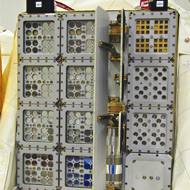 |
|
|
|
| Expose-E |
|
|
|
Together
with the European Columbus module, two ESA-Instruments were
launched to the ISS under the coordination of the DLR in Cologne
and the operational support by MUSC: EXPOSE-E in February
2008 and EXPOSE-R in November 2008. The European Exposure
Facility EXPOSE-E was accommodated outside of the Columbus
module on the European Technology Exposure Facility EuTEF
together as one of 9 instruments. The samples of the 8 international
biological, organic chemical and dosimetric experiments are
exposed in 4 compartments each in 3 trays to the extreme and
hostile space environment. Organic chemical compounds and
resistant species ranging from bacteria, bacterial spores
and Achaea to fungi, lichens and plant seeds are exposed more
than one year to the vacuum, temperature oscillations and
extraterrestrial radiation of Low Earth Orbit (LEO). While
the majority of the experiments on both EXPOSES are interested
in the effect of the space conditions, one tray of EXOSE-E
simulates Martian conditions with respect to inner tray atmosphere
(mostly CO2) at low pressure of 6 mbar, and UV radiation attenuated
by optical filter combinations. Parallel to the EXPOSE-E mission,
identical samples in a similar hardware are exposed to environmental
conditions simulated as close as possible according to the
temperature and UV-data obtained from the experiment on the
ISS and linked via MUSC to the Planetary and Space Simulation
Facilities at DLR In Köln-Porz.
|
|
|
|
In
addition, the data from ISS are made available for all 8 international
research groups participating on Expose-E (Telemetriedaten
EXPOSE-E). For Expose-R, temperature and instrument
status data are available from the beginning of the operational
phase. After approximately 6 months, UV-data will be retrieved
from a physically returned data carrier and made available to
the respective Scientists. As for EXPOSE-E, a mission parallel
ground simulation program utilizing the environmental data from
EXPOSE-R on ISS, will be performed at DLR/MUSC.
At the end of the missions, EXPOSE-E on EuTEF will be brought
back form ISS by Space Shuttle, in Autumn 2009 after approximately
1.5 years of exposure, and the 3 trays with the scientific sample
of EXPOSE-R by a Soyuz capsule after approximately 1 year exposure
in May 2010. Samples will be de-integrated and distributed to
the individual science groups for analysis in their respective
laboratories.
From the reactions of the organic molecules and the survivability
of the organisms that were exposed to the harsh space conditions,
as well as from the analysis of the space-condition induced
damage, valuable information increasing our knowledge about
the origin, evolution and distribution of life are expected.
Results will support the aim of planetary protection: the efforts
to not contaminate other celestial bodies like Mars with organisms
travelling as stowaways on future missions from Earth to the
planet of interest. Especially resistant organisms that might
be able to survive the transfer to Mars and the environmental
conditions on Mars need to be detected, their survivability
assessed and corresponding precautions to be taken.
While on EXOSE-E more than 400 samples are exposed, more than
1200 samples are accommodated on EXPOSE-R, partly in three layers.
Experiments on both EXOSES are complemented by the passive dosimeters
distributed between and below the biological samples and the
active R3D instruments.
|
|
|
|
Passive
Dosimetry on both EXPOSES are performed in the experiment
DOSIS on EXPOSE-E and as part of the biological SPORES experiment
of EXPOSE-R by the department of Radiation Biology of the
Institute of Aerospace Medicine at DLR, as are the biological
experiments SPORES itself on EXPOSE-R and ADAPT and PROTECT
on EXPOSE-E. Both PIs, Dr. Gerda Horneck (SPORES and PROTECT)
and Dr. Petra Rettberg (ADAPT) from DLR at Cologne are supported
by international consortia of scientists, that are waiting
for the return of their space-travelling organisms to their
laboratories. The same is true for the passive dosimetry experiments
of PI Dr. Guenther Reitz, also from DLR in Cologne.
In addition, DLR/MUSC operationally supports both EXPOSE facilities,
for EXPOSE-E as Facility Support Center, and coordinates and
performs both mission parallel Ground Reference experiments.
Expertise and the technical Planetary and Space Simulation
Facilities were built up in the last decades, when previous
astrobiological and biophysical space experiments were prepared
and missions simulated, and adapted for the requirements of
the current missions. In 2009, the two parallel EXPOSE missions
will be simulated in parallel on Ground, to complement scientific
data from the space experiments.
|










